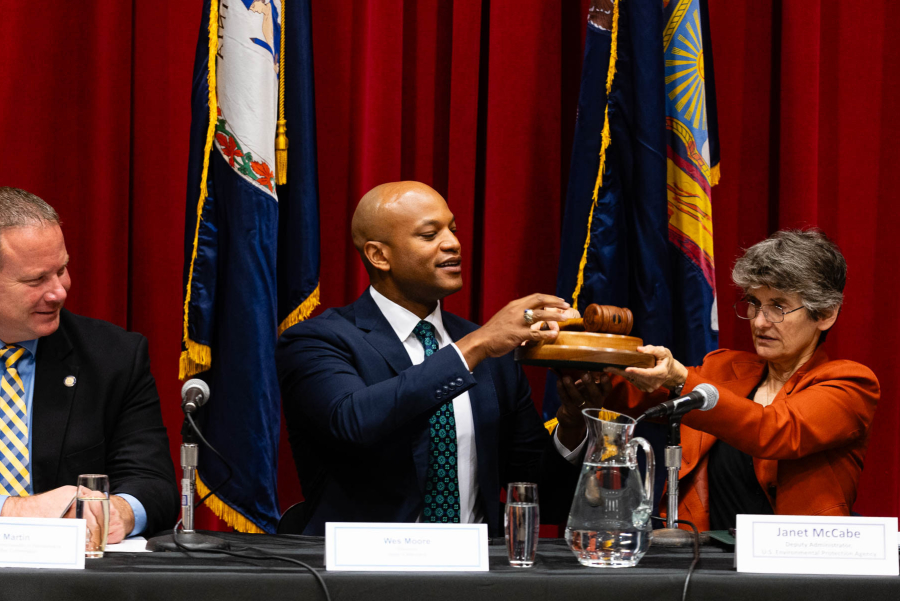Anacostia River successes serve as backdrop for annual Executive Council meeting
Maryland Governor Wes Moore elected 2024 chair

Forty years ago, the Anacostia River had a dim future. Coined “The Forgotten River”, Washington’s industrial sector used it as their dumping ground for pollutants and chemical contaminants. Trash and sewage regularly floated along its surface and a permanent stench emanated into the communities living along its banks.
Given this history, it was particularly poignant on a beautiful October day to see members of the Chesapeake Executive Council walking the grounds of the National Arboretum in Washington, D.C.—which lies in the Anacostia watershed—to marvel at several restoration sites that are helping to improve the health of the river.
“We’re proud to highlight the remarkable progress of the Anacostia watershed and we’re proud to be part of this regional community that remains just as committed today as we were 40 years ago,” said D.C. Mayor Muriel Bowser.
In 1983, the governors of Maryland, Pennsylvania and Virginia gathered along with the administrator of the Environmental Protection Agency and the chair of the legislative, tri-state Chesapeake Bay Commission to set the foundation for the Chesapeake Bay Program. Written into the original Chesapeake Bay Agreement was the formation of the Chesapeake Executive Council. Responsible for guiding the policy agenda and setting conservation and restoration goals for the Chesapeake Bay Program, membership has expanded to include the governors of Delaware, New York and West Virginia.
Touring these restoration sites as part of their annual meeting allowed members to really see how they are making an impact—and can continue to—on cleaning up local waterways, as well as the Chesapeake Bay.
“The work that has been done to restore the Chesapeake Bay has been nothing short of miraculous,” marveled West Virginia Governor Jim Justice. “West Virginia, in partnership with our neighboring states within the Bay Program and local stakeholders, will persist with our efforts to ensure that future generations have the opportunity to enjoy this one-of-a-kind resource.”
But this meeting had a much broader focus than the restoration of the Anacostia River watershed—members accepted the recommendations of the Charting a Course to 2025 report. At their previous meeting, the Executive Council directed the Bay Program’s Principals’ Staff Committee to recommend a critical path forward that would prioritize and outline the next steps for meeting the goals and outcomes of the current Chesapeake Bay Watershed Agreement. The recommendations were formed after each of the 31 outcomes were assessed for their attainability in meeting their goals by 2025—the target for many of them. Additionally, information, data and research from subject matter experts representing diversity, equity, inclusion and justice, climate change, forest buffers, wetlands, water quality, monitoring and several others helped to inform the recommendations. They are as follows:
Accelerate investments: Thanks to the American Rescue Act, Infrastructure Investment and Jobs Act and increased state investments, the partnership will accelerate restoration activities over the next 18 months. The speed and scale of this funding will be increased with a particular emphasis on addressing lagging outcomes.
Integrate emerging science and monitoring: Recent scientific reports and findings have provided further understanding of how the Chesapeake Bay and its surrounding watershed are responding to the implementation of best management practices, impacts from climate change and a rise in environmental stewardship, to name a few. The Chesapeake Bay Program is already evaluating how to integrate insights from such recent reports as the A Comprehensive Evaluation of System Response, Rising Watershed and Bay Water Temperatures, Enhancing Chesapeake Bay Partnership Activities by Integrating Social Science and Enhancing the Chesapeake Bay Program Monitoring Networks (note: this is not an exhaustive list) into its work. These are significant scientific findings that call for an increased focus on geographic targeting, social science, robust monitoring networks, the environmentally and economically important shallow waters of the Bay and addressing rising water temperature implications, and will take time and careful planning to ensure they are thoughtfully and accurately fully reflected into the Bay Program’s work. The partnership will also use these next 18 months to prepare for how these findings will be used in the next phase of Bay protection and restoration while taking steps to integrate emerging science now.
Fast-track action plans: Over the past few years, and in recent months, several action plans have been put into place across the partnership. The Chesapeake Bay Program will lean harder into the implementation of these plans moving toward 2025. These include, but are not limited to, the jurisdictions’ Phase III WIPs, Diversity, Equity, Inclusion and Justice (DEIJ) Strategy, Implementation Plan, state riparian buffer action strategies, Wetlands Action Plan and Climate Change Directive—Workplan.
At the 2024 Executive Council meeting, members will be presented with recommendations that continue to address new advances in science and restoration, along with a focus on the partnership for going beyond 2025.
During the members’ private business meeting, the Council heard reports from the Bay Program’s three advisory committees that represent local government, stakeholder and scientific interests. Additionally, Maryland Governor Wes Moore was unanimously voted to be the next Executive Council chair.
“I’m honored and deeply humbled to serve as the chair of the Executive Council,” stated Governor Moore. “The Chesapeake Bay is part of who we are as Marylanders—and plays a vital role in our state’s environment and economy. Maryland is ready to take the lead on this important work, and we know we won’t be working alone. I am optimistic that if we take shared responsibility, hold each other accountable and follow the science—we can achieve our vision of a cleaner, healthier Bay for all.”
More information about the meeting can be found on the 2023 Chesapeake Executive Council meeting page.

Comments
There are no comments.
Thank you!
Your comment has been received. Before it can be published, the comment will be reviewed by our team to ensure it adheres with our rules of engagement.
Back to recent stories